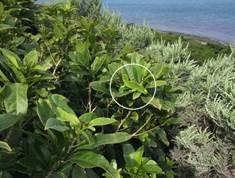
Credit: Tom Flynn-Plummer
University of Otago researchers have added another piece to the puzzle about how best to translocate New Zealand lizards for conservation purposes – confine them.
In a paper just published in the New Zealand Journal of Ecology, the Department of Zoology researchers outlined how they translocated 19 barking geckos to Mana Island, using the method of penned release – enclosing them in a 100m² pen for three months so they get used to the site and hopefully establish a breeding population.
It was the first time such a method had been used with the species and the researchers found it worked well. The geckos’ area use decreased over time, indicating territory establishment.
Co-author Dr Jo Monks, Otago Honorary Research Fellow and Department of Conservation Science Advisor, says translocations of reptiles and amphibians has, historically and globally, been notoriously unsuccessful. However, recent penned release success of jewelled geckos prompted them to try with a different species.
“By understanding the behavioural response of barking geckos to a penned release, this research is helping us to understand which techniques best help a new population of geckos establish following translocation to a new site,” she says.
Barking geckos are one of nine green gecko, moko-kākāriki, species that only live in Aotearoa New Zealand. They are considered ‘At Risk – Declining’ under New Zealand’s Threat Classification System due to ongoing predicted declines from habitat destruction and predation by introduced mammals.
Many green gecko populations have undergone decline in numbers and locations due to predators, habitat modification, and poaching for illegal trade, but little research on their ecology exists.
“Protecting barking geckos and other reptiles of Aotearoa is important in its own right and for the mauri of ecosystems in which they have important roles as pollinators and seed dispersers as well as being predators of invertebrates and prey of larger animals,” Dr Monks says.
There is potential for penned release to work for a wide range of fauna where initial dispersal following translocation could be detrimental to species establishment. It has been done for birds and lizards in Aotearoa.
###
Publication details:
Penned release reduces area use by translocated barking geckos (Naultinus punctatus)
Tom P. Flynn-Plummer and Joanne M. Monks
New Zealand Journal of Ecology
https:/
Media Contact
Dr Jo Monks
[email protected]
Original Source
https:/
Related Journal Article
http://dx.




